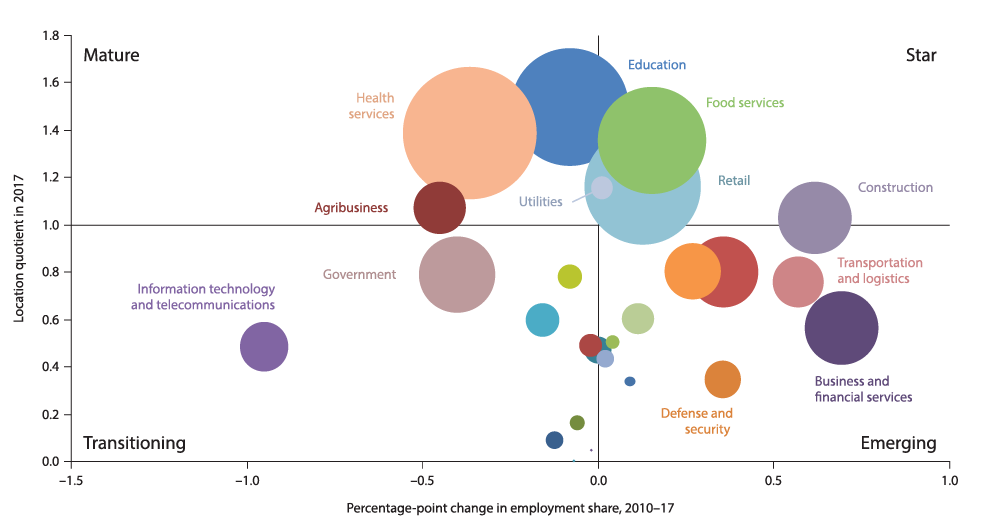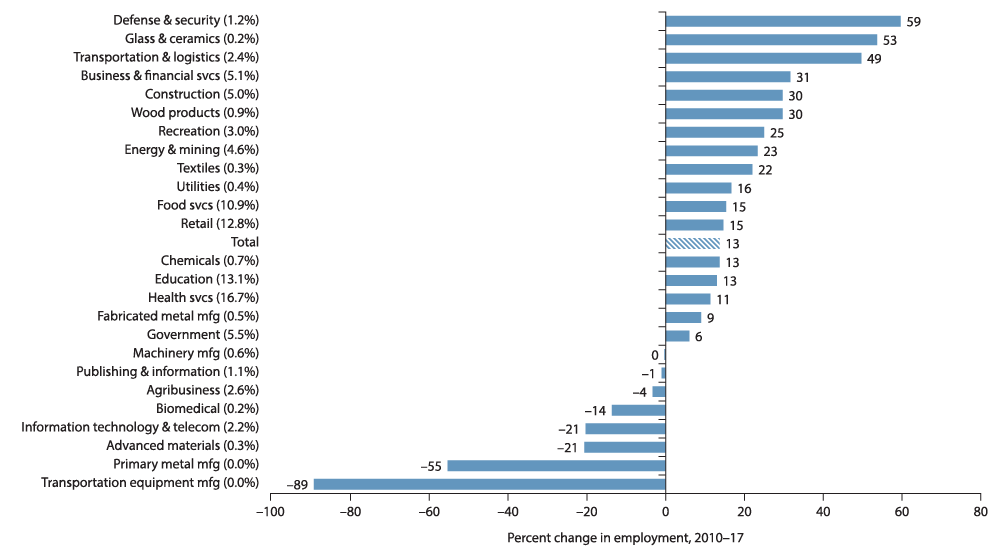At the heart of Texas: Cities’ industry clusters drive growth
Lubbock: Texas Tech, agriculture work together in Plains economy
- Print version
- Additional tables: Lubbock location quotients, employment shares, average annual earnings, demographics
At a glance

Population (2017): |
316,983 |
Population growth (2010–17): |
8.5 percent (Texas: 12.1 percent) |
Median household income (2017): |
$47,276 (Texas: $59,206) |
National MSA rank (2017): |
No. 158* |
| *The Lubbock metropolitan statistical area (MSA) encompasses Crosby, Lubbock and Lynn counties. | |
- Texas Tech University and agriculture have shaped Lubbock’s development since the early 20th century.
- Education, health, retail and food sectors are major contributors to economic activity.
- A large student population helps explain the area’s relatively low median household income and disproportionate population shares of 15–24-year-olds and college degree holders relative to the overall state.
History: rooted in agriculture and education
Lubbock’s settlers came in search of land to cultivate in the late 1800s. Other settlements dotted the West Texas plains, though Lubbock’s growth stood out, driven by the railroad. The city was formally established in 1909, and later that year, the Santa Fe Railway arrived. Lubbock’s 1910 population doubled over the following decade, to 4,051 residents in 1920.
In 1923, the Legislature designated Lubbock as the home of Texas Technological College, known as Texas Tech University since 1969. Agriculture remained a vital component of economic activity, particularly cotton and sorghum farming. By the mid-20th century, Lubbock accounted for a major portion of the global cottonseed-processing industry.[1]
Industry clusters: Location quotients assess economic drivers
Location quotients (LQs), which compare the relative concentration of various industry clusters locally and nationally, are a convenient way of assessing key drivers in an economy. An LQ exceeding 1 indicates that a specific industry cluster carries more relative weight locally than nationally.[2]
Clusters in the top half of Chart 12.1, such as food services and retail, have a larger share of employment relative to the nation and, thus, an LQ greater than 1. These clusters are generally vital to the area’s economy and can be expanding relatively rapidly (“star”) or slowly (“mature”). Those in the bottom half, such as defense and security and information technology and telecommunications, are less dominant locally than nationally and, hence, have an LQ less than 1. “Emerging” clusters are fast growing; those growing slowly are “transitioning.”

NOTE: Bubble size represents cluster share of metropolitan statistical area employment.
SOURCES: Texas Workforce Commission; Bureau of Labor Statistics.
Health services, Lubbock’s largest industry cluster, encompasses nearly 17 percent of total employment and is 1.4 times more concentrated in Lubbock than in the U.S. on average. Major health services employers include University Medical Center, Covenant Health System and Lubbock Heart Hospital. University Medical Center is a public hospital, employing more than 4,600 people. The institution serves as the primary teaching hospital for the Texas Tech University Health Sciences Center, training 400 students annually for careers in nursing and medicine.
Education, Lubbock’s second-largest industry cluster, employs 13 percent of the workforce. The education cluster’s major employers include Lubbock's independent school districts, Texas Tech, Lubbock Christian University and Wayland Baptist University.[3]
Texas Tech and its nearly 6,000-person payroll account for a significant portion of the education cluster employment. The university’s Health Sciences Center employed 3,400 people as of September 2016. Student enrollment at Texas Tech alone totaled 37,000 (11.7 percent of the metro population) in fall 2017.[4] At least $2.1 billion of annual economic output in 2015 (latest estimate available) was attributed to Texas Tech—including research expenditures, university operations and visitors throughout the Lubbock metropolitan statistical area and nearby counties.[5]
Lubbock’s retail cluster accounts for 13 percent of the workforce, amounting to 1.2 times the cluster’s concentration in the U.S. The food services cluster is similarly large, encompassing nearly 11 percent of the workforce. In 2017, food services employment was 1.4 times more concentrated in Lubbock relative to the U.S.
Jobs in crop production and food manufacturing make up much of the agribusiness cluster, which is slightly more concentrated in Lubbock than in the U.S. overall. Texas’ broader High Plains region, which includes Lubbock, harvests 25 percent of the annual U.S. cotton crop.[6] Agribusiness giant Monsanto, a Fortune 500 firm, scheduled the opening of a nationwide cottonseed processing center in Lubbock in 2018.
Lubbock’s fastest-growing industry clusters from 2010 to 2017 reveal a diverse mix (Chart 12.2). Recent employment growth may be partially due to increased residential construction activity.[7] Glass and ceramics job growth mainly reflects expansion in cement and concrete product manufacturing.

NOTES: Percent change in employment is shown in whole numbers. Each cluster’s share of total jobs is shown in parentheses (rounded to one decimal place).
SOURCES: Texas Workforce Commission; authors’ calculations.
Annual earnings for workers in clusters with an LQ above 1 averaged $40,200 in 2017, lower than the metro average of $42,200 (Table 12.1). This subset includes the food services and retail clusters, which depress the area’s average wages. Education and health services have the converse effect, raising the average earnings. Overall, in real (inflation-adjusted) terms, average annual earnings inched up 6.3 percent by 2017 from levels in 2010.
| Cluster | Lubbock | U.S. | |||||
| 2010 | 2012 | 2014 | 2016 | 2017 | 2017 | ||
| Education | 50,322 | 49,112 | 49,869 | 51,365 | 50,976 | 49,322 | |
| Health services | 47,913 | 45,366 | 48,227 | 50,237 | 50,845 | 56,001 | |
| Food services | 15,864 | 16,267 | 16,587 | 16,681 | 16,700 | 18,963 | |
| Retail | 27,698 | 28,239 | 29,374 | 29,432 | 29,570 | 31,216 | |
| Utilities | 79,168 | 79,021 | 79,770 | 81,125 | 83,849 | 107,188 | |
| Agribusiness | 44,626 | 43,382 | 44,243 | 43,997 | 46,548 | 44,576 | |
| Construction | 40,502 | 44,337 | 44,448 | 47,552 | 48,250 | 60,742 | |
| Clusters with location quotient > 1 | 38,168 | 37,081 | 38,786 | 39,245 | 40,212 | – | |
| Clusters with location quotient < 1 | 46,591 | 46,566 | 47,898 | 48,237 | 48,620 | – | |
| Average earnings (total) | 39,745 | 39,845 | 40,878 | 41,920 | 42,242 | 55,375 | |
| NOTES: Clusters are listed in order of location quotient (LQ); clusters shown are those with LQs greater than 1. Earnings are in 2017 dollars. SOURCES: Texas Workforce Commission; Bureau of Labor Statistics; authors’ calculations. |
|||||||
Annual earnings for workers in clusters with an LQ less than 1 averaged $48,600 in 2017, slightly more than the metro average.
Demographics: future professionals in training
Lubbock’s college student population partially explains wage, age and education trends. Real median household income was little changed in Lubbock from 2014 to 2017. Lubbock’s median household income, $47,276, also trails the state figure of $59,206.
Lubbock’s 15–24-year-olds make up 20.3 percent of the local population compared with the statewide figure of 14.3 percent in 2016. A sizable, highly educated population also resides in Lubbock, with 30.2 percent of the population age 25 and older holding a bachelor’s degree or higher, compared with 28.9 percent for the state. The college-student population likely explains Lubbock’s relatively young median age: 30.8 years compared with 34.5 years for the state.
Higher education should continue leading Lubbock in the future, especially as Texas Tech’s footprint continues to expand and support services grow. Agribusiness provides an important link between regional interests and growing global markets.
—Alexander T. Abraham
Notes
- The history of Lubbock has been adapted from the Texas State Historical Association’s Handbook of Texas, tshaonline.org/handbook/online/articles/hdl04.
- The percentage shares of individual clusters do not add to 100 because some industries are counted in multiple clusters, and some industries are not counted at all based on cluster definitions. (See the appendix for more information.)
- The Lubbock Economic Development Alliance publishes a list of major employers and number of employees in Lubbock, lubbockeda.org/data-map-center/major-lists/local-major-employers/.
- Texas Tech University provides a brief institution profile, www.ttu.edu/about/.
- See the “Economic Impact Report,” by Bradley Ewing, January 2013, www.ttu.edu/administration/president/pdf/TTU_EconomicImpactReport.pdf. Additionally impacted areas include Garza, Dickens, King, Motley, Floyd, Hale, Lamb, Bailey, Cochran, Hockley, Yoakum and Terry counties.
- For Texas A&M Forest Service’s definition of Texas’ High Plains region, see texastreeid.tamu.edu/content/texasEcoRegions/. For the Lubbock Chamber of Commerce’s facts about regional agriculture, see www.lubbockchamber.com/ag-facts.
- The annual value of all permits for new private-housing units doubled in 2017 from 2010 levels. Calculations were made using nominal housing permits data from the Census Bureau.